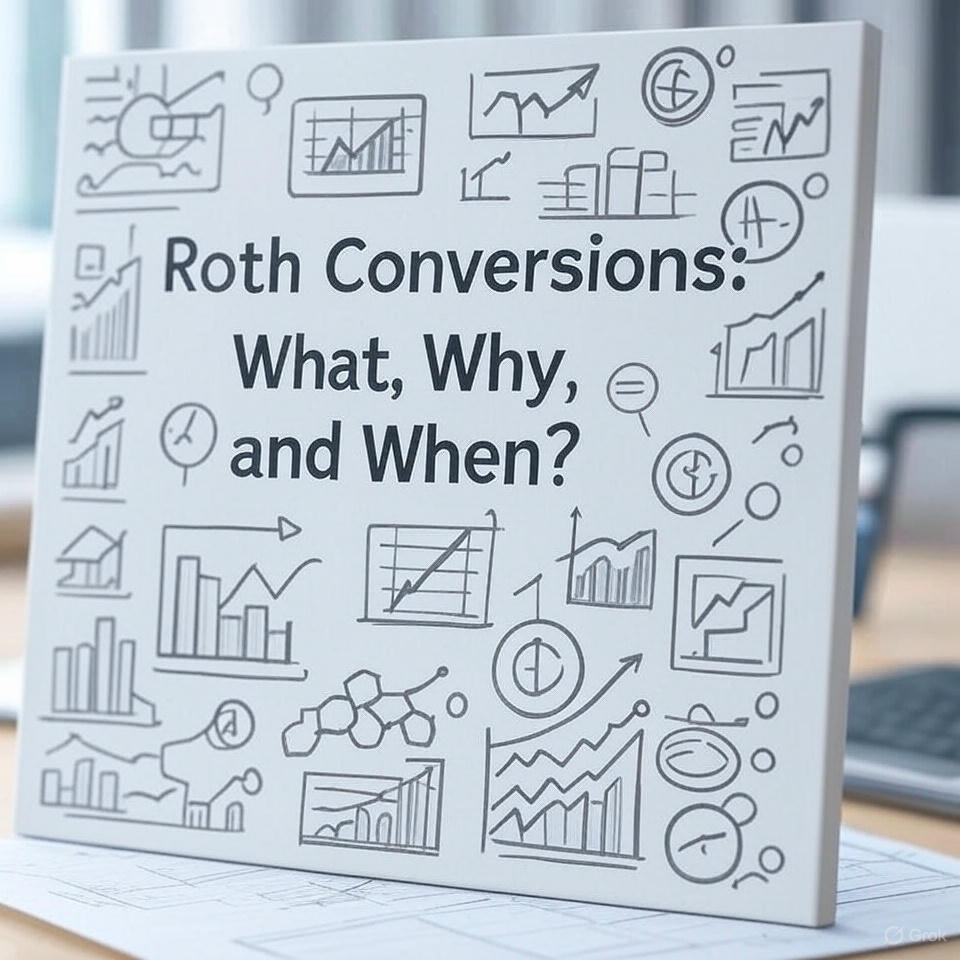Should You do a Roth Conversion?
A Roth conversion might sound like just another line item on a financial planning checklist, but it can be one of the most strategic moves you make for your long-term wealth.
Get it right and you could save thousands (or more) in future taxes. Get it wrong and you could trigger a hefty, unexpected IRS bill that eats into your retirement savings.
So, if you’ve ever wondered whether a Roth conversion makes sense for you, you’re asking the right question.
But before you pull the trigger, you need to understand how it works, why it can be valuable, and when it’s the right time to make your move.
What Is a Roth Conversion?
At its core, a Roth conversion is the process of moving money from a traditional retirement account (like a Traditional IRA or 401(k)) into a Roth IRA. When you do this, you pay taxes on the amount you convert, but once that money is in the Roth IRA, it grows tax-free – and can be withdrawn tax-free in retirement (as long as you follow the rules).
Think of it like paying taxes now to avoid paying taxes later. Traditional accounts give you a tax break today, but you’ll owe income tax on the withdrawals down the line. Roth accounts flip that equation – no tax break now, but tax-free income later.
Why Consider a Roth Conversion?
There are a few big reasons a Roth conversion could make sense:
- You expect to be in a higher tax bracket later.
If you think your income – or tax rates in general – will be higher in retirement than they are today, converting now lets you lock in today’s lower tax rate. That’s especially relevant if you’re in a temporary dip in income, such as during a career transition, sabbatical, or early retirement phase.
- You want tax-free income in retirement.
One of the biggest benefits of a Roth IRA is that qualified withdrawals are completely tax-free. That means more predictability and flexibility when it comes to managing your retirement income.
- You want to reduce Required Minimum Distributions (RMDs).
Traditional IRAs and 401(k)s come with mandatory withdrawals starting at age 73. These RMDs can spike your taxable income in retirement. Roth IRAs don’t have RMDs during your lifetime, so converting reduces your future tax burden.
- You’re planning for your heirs.
Roth IRAs are also a great estate planning tool. Your beneficiaries can inherit the account income-tax-free (though they must follow distribution rules). That means you’re not just saving for yourself – you’re building a tax-efficient legacy.
When Is the Right Time?
This is the tricky part. The best time to do a Roth conversion isn’t the same for everyone. It depends on your income, your age, your retirement timeline, and your goals.
Here are a few signs that now might be the right time:
- You’re in a low-income year. Let’s say you just retired early, or took time off work. Your taxable income might be lower this year than it will be once you start collecting Social Security, pensions, or investment income. That creates a window where a Roth conversion could be taxed at a lower rate.
- You’re years away from taking RMDs. The earlier you convert, the more time that money has to grow tax-free – and the more RMDs you might be able to avoid. Converting in your 50s or early 60s (before RMDs begin) can be especially powerful.
- You’re below the threshold for a higher tax bracket. You can do partial conversions each year to “fill up” your current tax bracket without spilling into the next one. This strategy spreads out your tax bill and avoids big surprises.
Avoiding Common Pitfalls
A Roth conversion isn’t just a tax decision – it’s a cash flow and timing decision too. Here’s how to avoid the most common mistakes:
- Don’t convert too much at once. Large conversions can push you into a higher tax bracket, resulting in a bigger tax bill than necessary. Instead, consider converting smaller amounts over several years.
- Don’t use retirement funds to pay the tax. If you pull money from the same IRA to cover the tax bill, you’re reducing your long-term gains – and possibly incurring early withdrawal penalties if you’re under 59½. Ideally, you should pay the taxes from a taxable account.
- Don’t forget about Medicare and Social Security thresholds. Converting too much in one year could increase your Medicare premiums or make more of your Social Security benefits taxable. Be sure to run the numbers before you act.
So… Should You Do a Roth Conversion?
The answer to the original question is, it depends.
If you expect higher tax rates in the future, have the cash to pay the tax bill, and want to build tax-free income for retirement, a Roth conversion could be a smart move. But it’s not one-size-fits-all. What works for your friend or neighbor might not work for you.
The real key? Don’t make the decision in isolation. Talk to a financial planner or tax advisor who understands your full financial picture. Timing and strategy are everything – and when you get them right, a Roth conversion can be one of the most valuable financial moves in your retirement playbook.
Adding it All Up
Roth conversions are really about control. They give you more flexibility with your future income, more room to breathe during retirement, and more tools to manage your financial future on your terms.
So take your time, run the numbers, and make the move only when it fits your bigger picture.






